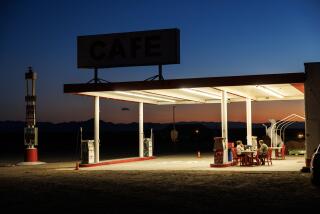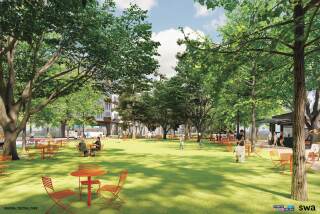Spirit of 66
- Share via
You can still get your kicks on Route 66.
“It’s no longer a highway; it’s lost its highway status; there are no official signs,” said Lynn La Bate, curator of “Return to Route 66: Photographs From the Mother Road,” opening Friday at the Fullerton Museum Center. “But it hasn’t stopped speaking to people’s memories and to a time before America became so generic.
“For older people, it speaks to vacations that they took, maybe trips they took with their parents,” La Bate said. “For younger people today, it’s an adventure. Not all the road is there. Traveling on Route 66 you get off the freeway. It’s one of this country’s quintessential road trips.”
Indeed, in many ways Route 66 symbolizes “the road.”
Memorabilia at the exhibit, which marks the route’s 70th anniversary, includes restored gasoline pumps, a Tireflator, original Burma-Shave signs and U.S. 66 road signs. Among photographs are one by Dorothea Lange from 1938 and others on loan from the California Historic Route 66 Assn.
Contemporary photographs by Shellee Graham of St. Louis, taken over the course of 10 years and dozens of road trips, provide a focal point for the show.
“It’s like going back in time when I take these trips, seeing what once was, what many people call a simpler time,” said Graham, reached by phone at her home last week; she’ll speak at the museum on Friday. “Going through certain towns in New Mexico at night, it’s like 1950, a time warp.
“What fascinates me is that you can still take this trip. You can stay in 1930s motels, these mom-and-pop places; there are abandoned stretches with hauntingly beautiful cafes; there’s this 90-foot totem pole in Oklahoma. . . . There’s a lot that’s unchanged, a lot that has not been torn down. And a lot that’s being renovated.”
Others who have taken the trip can write down their recollections on postcards provided by the museum; the postcards will be placed on a large map painted onto one of the museum’s walls.
Printed maps date to 1914 and include a reproduction of one on which Oklahoman Cyrus Avery traced the highway that he envisioned as connecting the Midwest with California: a 2,448-mile asphalt ribbon stretching from Chicago to the corner of Santa Monica Boulevard and Ocean Avenue.
Avery’s timing was excellent. When Henry Ford lowered the price of his automobile, the middle class suddenly had wheels, and in 1921 interstate highways became a reality. Route 66 was dedicated five years later, with only 800 of its miles paved. The Fullerton show traces the road’s history from the 1920s to the present.
Those who used it in the ‘30s were often fleeing the Dust Bowl and seeking a new life; author John Steinbeck dubbed it “The Mother Road” in his book about those refugees, “The Grapes of Wrath.” (A 1939 copy will be on view.) In the ‘40s the route served the war effort. Vacationers headed for Disneyland when the amusement park opened in the ‘50s.
In 1956, the interstate highway system was overhauled, and Route 66 gradually became a relic. Five new interstates replaced it, according to La Bate. The last bypass went through more than 10 years ago in Arizona.
The exhibit chronicles the devastating effect the highway’s demise had on many lives.
“There are still people who live along Route 66,” La Bate pointed out. “One man, Angel Delgadillo, had a very successful barber shop on Route 66, and his brother had a drive-in. One day they had a successful business; the next day their livelihoods were virtually gone.”
Delgadillo was instrumental in organizing Arizona’s Route 66 Assn., which has more than 1,000 members; each of the eight states through which Route 66 passes has such an organization. Four years ago, the 66th anniversary of Route 66 helped to inspire a revival of public interest.
Not that interest has ever been exactly low.
Three TV Guide covers on display at the museum, from star Martin Milner’s collection, spotlighted the popular “Route 66” television show. The series, about two guys in a Corvette, ran from 1960 to ’64. George Maharis was Milner’s first partner, replaced by Glenn Corbett in the show’s final year.
Also on display is a 78 rpm recording by Bing Crosby and the Andrews Sisters featuring Bobby Troup’s song “Route 66.” Nat King Cole first recorded the song in 1946, followed over the course of half a century by a variety of artists including the Rolling Stones, Perry Como, Van Morrison, Johnny Mathis, Chuck Berry and Asleep at the Wheel.
“It’s the most famous highway in the world,” Graham noted. “And the most romanticized.”
* What: “Return to Route 66: Photographs From the Mother Road.”
* When: Friday through March 15. Open Wednesday and Friday through Sunday from noon to 4 p.m. and Thursday from noon to 8 p.m.
* Where: Fullerton Museum Center, 301 N. Pomona Ave.
* Whereabouts: Take the Riverside (91) Freeway to the Harbor Boulevard exit and head north. Turn right on Wilshire Avenue and left on Pomona Avenue.
* Wherewithal: $2-$3. Thursdays from 6 to 8 p.m., free.
* Where to call: (714) 738-6545.
More to Read
Sign up for The Wild
We’ll help you find the best places to hike, bike and run, as well as the perfect silent spots for meditation and yoga.
You may occasionally receive promotional content from the Los Angeles Times.






